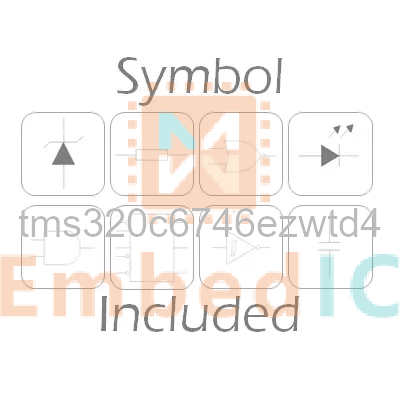IC DSP FIX/FLOAT POINT 361NFBGA
 PCB Symbol, Footprint
PCB Symbol, Footprint
 Send Inquiry
Send Inquiry
 Download Datasheet
Download Datasheet
 SUPPLIERS WHOLESALE PRICE TRENDS
SUPPLIERS WHOLESALE PRICE TRENDSPrice comparison from authorized distributors
 TMS320C6746EZWTD4 Competitive Prices
TMS320C6746EZWTD4 Competitive Prices
EmbedIC has the unique source of supply. We can offer TMS320C6746EZWTD4 more competitive price for our customers. You can enjoy our best service by purchasing Texas Instruments TMS320C6746EZWTD4, Please feel free to contact for the best price of TMS320C6746EZWTD4 DSP. Click To Get Quotation
The TMS320C6746 fixed- and floating-point DSP is a low-power applications processor based on a C674x DSP core. This DSP provides significantly lower power than other members of the TMS320C6000? platform of DSPs.
The device enables original-equipment manufacturers (OEMs) and original-design manufacturers (ODMs) to quickly bring to market devices with robust operating systems, rich user interfaces, and high processor performance through the maximum flexibility of a fully integrated, mixed processor solution.
The device DSP core uses a 2-level cache-based architecture. The level 1 program cache (L1P) is a32-KB direct mapped cache, and the level 1 data cache (L1D) is a 32-KB 2-way, set-associative cache. The level 2 program cache (L2P) consists of a 256-KB memory space that is shared between program and data space. L2 memory can be configured as mapped memory, cache, or combinations of the two. The DSP L2 is accessible by other hosts in the system.
The peripheral set includes: a 10/100 Mbps Ethernet media access controller (EMAC) with a management data input/output (MDIO) module; one USB2.0 OTG interface; two I2C Bus interfaces; one multichannel audio serial port (McASP) with 16 serializers and FIFO buffers; two multichannel buffered serial ports (McBSPs) with FIFO buffers; two serial peripheral interfaces (SPIs) with multiple chip selects; four 64-bit general-purpose timers each configurable (one configurable as a watchdog); a configurable 16-bit host-port interface (HPI); up to 9 banks of general-purpose input/output (GPIO) pins, with each bank containing 16 pins with programmable interrupt and event generation modes, multiplexed with other peripherals; three UART interfaces (each with RTS and CTS); two enhanced high-resolution pulse width modulator (eHRPWM) peripherals; three 32-bit enhanced capture (eCAP) module peripherals which can be configured as 3 capture inputs or 3 APWM outputs; two external memory interfaces: an asynchronous and SDRAM external memory interface (EMIFA) for slower memories or peripherals; and a higher speed DDR2/Mobile DDR controller.
The EMAC provides an efficient interface between the device and a network. The EMAC supports both 10Base-T and 100Base-TX, or 10 Mbps and 100 Mbps in either half- or full-duplex mode. Additionally, an MDIO interface is available for PHY configuration. The EMAC supports both MII and RMII interfaces.
The Universal Parallel Port (uPP) provides a high-speed interface to many types of data converters, FPGAs, or other parallel devices. The uPP supports programmable data widths between 8- to 16-bits on both channels. Single-data rate and double-data rate transfers are supported as well as START, ENABLE, and WAIT signals to provide control for a variety of data converters.
A video port interface (VPIF) provides a flexible video I/O port.
The rich peripheral set provides the ability to control external peripheral devices and communicate with external processors. For details on each peripheral, see the related sections in this document and the associated peripheral reference guides.
The device has a complete set of development tools for the DSP. These tools include C compilers, a DSP assembly optimizer to simplify programming and scheduling, and a Windows debugger interface for visibility into source code execution.
Symbol

Footprint

Clock Rate 456MHz
Operating Temperature -40℃ ~ 90℃ (TJ)
Type Fixed/Floating Point
Non-Volatile Memory ROM (1.088 MB)
Package / Case 361-LFBGA
Voltage - Core 1.00V, 1.10V, 1.20V, 1.30V
Voltage - I/O 1.8V, 3.3V
Mounting Type Surface Mount
Interface EBI/EMI, Ethernet MAC, Host Interface, I2C, McASP, McBSP, SPI, UART, USB
Supplier Device Package 361-NFBGA (16x16)
On-Chip RAM 488kB
Manufacturer: ON Semiconductor
IC CTRLR POWER DGTL EEPROM 14DIP
Product Categories: MCU
Lifecycle:
RoHS:
Manufacturer: Zilog
IC TV/VCR CTRL 24K OTP 40-DIP
Product Categories: DSP
Lifecycle:
RoHS:
Manufacturer: Zilog
IC 32K 8 BIT DTC OTP 42-DIP
Product Categories: MCU
Lifecycle:
RoHS:
Manufacturer: Cypress
IC MCU 16BIT 96KB FLASH 80LQFP
Product Categories: 16bit MCU
Lifecycle:
RoHS:
Manufacturer: Infineon
IC MCU 16BIT 128KB FLASH 64LQFP
Product Categories: 16bit MCU
Lifecycle:
RoHS:
Manufacturer: Infineon
IC MCU 16BIT 256KB FLASH 100TQFP
Product Categories: 16bit MCU
Lifecycle:
RoHS:
Manufacturer: Infineon
IC MCU 16BIT 128KB FLASH 64LQFP
Product Categories: 16bit MCU
Lifecycle:
RoHS:
Manufacturer: Microchip
IC MCU FLASH 4K TX 315MHZ 24SSOP
Product Categories: MCU
Lifecycle:
RoHS:
Manufacturer: Cypress
IC MCU 8K USB LS PERIPH 48SSOP
Product Categories: General MCU
Lifecycle:
RoHS:
Looking forward to your comment
Comment
 Popular Searches
Popular Searches8 Bit MCU, Flash, PIC16 Family PIC16F7XX Series Microcontrollers, 20 MHz, 7 KB, ...
EEPROM 2K 256 X 8 2.5V SERIAL EE IND
System-On-Modules - SOM RCM2200
32-bit Arm Cortex-A53 vision processor with ISP, powerful 3D GPU, dual APEX-2 v...
IC MCU 8BIT 60KB FLASH 44QFP
DSP 20MHZ 44QFP
1
2
3
4
5
6